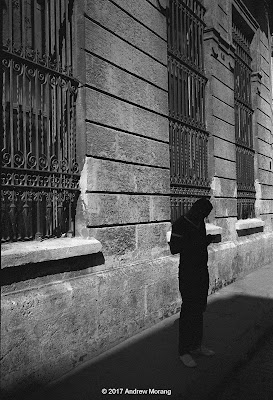Because of the contrasts and ironies, Havana is a visual delight. I highly recommended it for photographers - but do it the real way, use a film camera. For the pictures below, I used my Leica M2 35mm camera with Kodak Tri-X film to simulate a 1950s photojournalist look.
Let's take a semi-random walk through Havana Viejo. We have already briefly looked at the waterfront in a previous article (click the link). The photograph above is the Terminal Sierra Maestre, where cruise ships unload.
This is a block of somewhat rough apartment buildings on the Avenida de Bélgica, across the street from the Estación Central de Ferrocarriles (the central train station). To get there, I took a tricycle rickshaw, pumped by a very friendly driver. One of my maps showed a home of Jose Marti, but I am not sure if it is in the scene or on a side street.
On Teniente Rey, we saw school groups being taken to museums. All through the country, school children wear neat, clean uniforms and are mostly well-behaved. Education has been a high priority for the government.
At the Plaza de San Francisco, plenty of local folks hang out along with tourists.
Near the Casa Oswaldo Guayasamín (an Ecuadorian painter who was a friend of Fidel), there were interesting patterns of light and shadow.
Empedrado is a major road that leads west from the Castillo de la Real Fuerza at the waterfront as far as the Prado. The people-watching is great, and, as you can see, selfies have come to Havana.
Brazil (also known as Teniente Rey) also runs east-west and ends at the neoclassical El Capitolio. These people were waiting for a pharmacy or possibly a clinic.
The Ballet Nacional de Cuba is in a big hulking building on the corner of the Paseo del Prado and Colon. I heard tap dancers through the windows.
The Paseo del Prado (also shown on maps as the Paseo de Marti) is a tree-shaded boulevard with a broad pedestrian walk in the center. Everyone goes there to be seen and to watch. I saw mothers with their little girls in tutus, nuns, guys on skateboards, chess-players, and musicians. A 10 or 12-piece orchestra was set up on chairs and playing first-rate rhumbas and dance music. Elderly couples were gliding across the paving blocks. The grand architecture that lines the Paseo is a visual treat.
Camera notes: I took these photographs with a Leica M2 rangefinder camera with 35mm and 50mm Summicron lenses using Kodak Tri-X film. I developed the film in Kodak HC-110 developer, dilution H, for 10 min at 68° F. I scanned the negatives with a Plustek 7600i film scanner using SilverFast software.
Movie note: Our Man In Havana is Graham Green's 1958 novel, which was set in Cuba before the Revolution. It is about a vacuum cleaner salesman who may be a British spy, or maybe he isn't. The movie version (directed by Carol Reed of The Third Man fame) was filmed exactly as the revolution was underway. Fidel visited the set, and there is a rumor that he tried to get a date with Maureen O'Hara. He liked American actresses, and apparently many of them liked him.
 |
| Maureen O'Hara in Havana during filming of Our Man in Havana in 1959 (from IMDb) |
 |
| Fidel with the cast of Our Man in Havana |














No comments:
Post a Comment